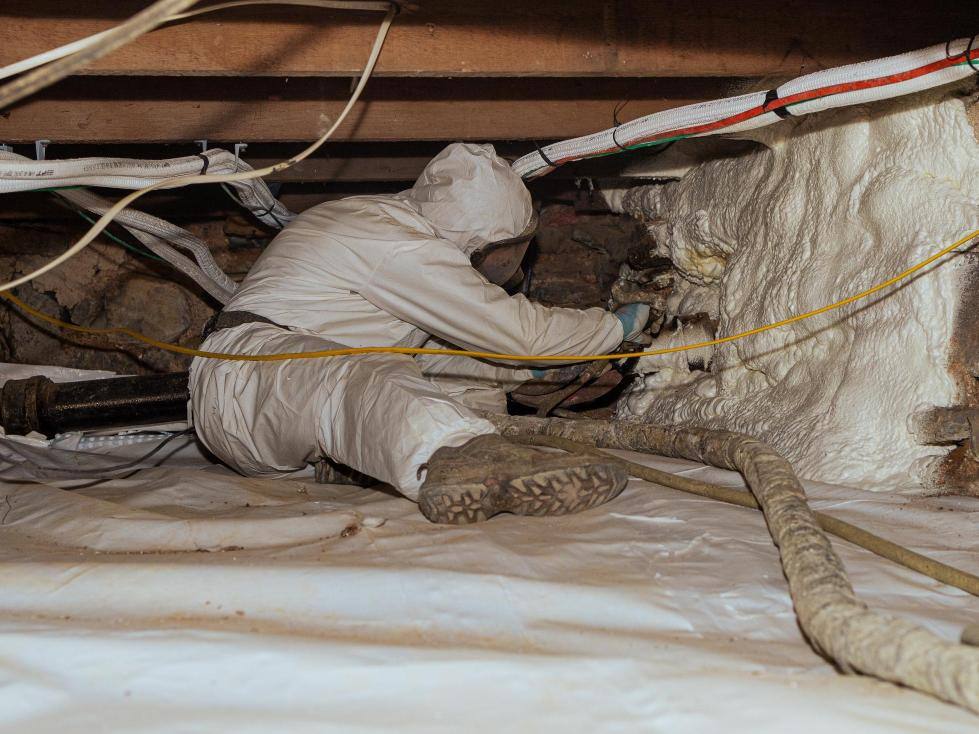Search for topics or resources
Enter your search below and hit enter or click the search icon.
November 6th, 2024
3 min read

The average crawl space near Greencastle, Pennsylvania, is dirty, damp, and smelly. Unmanaged moisture issues cause dampness and odor. One of the solutions for unmanaged moisture is vapor barriers. But what vapor barrier products should be used in a crawl space?
South Central Services has insulated hundreds of new and existing homes with spray foam. One of our most popular services is crawl space repair because we offer a solution to manage crawl space moisture. There are many options for crawl space vapor barriers, but these products must be installed correctly to deliver good results.
By the end of this article, you will understand what products can be used in crawl spaces to create vapor barriers.
Don't have time to read right now? Check out everything you need to know at a glance.
The best solution for a vapor barrier on your floor is polyethylene sheathing. Many crawl spaces already have some plastic tarp laid on the ground. Not every plastic tarp can create a vapor barrier.
Pay attention to thickness when looking for the right plastic sheathing for your crawl space. At South Central Services, we install a minimum of 12 mil thick sheathing. Anything thinner than 12 mil is not vapor permeable, but will likely not stand the test of time. When we are concerned about potential tearing in the sheathing, we install 20 mil.
Once you’ve secured the sheathing at the correct thickness, you need to seal the edges of the sheathing. Even if most plastic tarps in crawl spaces were thick enough to create a vapor barrier, they are rarely sealed. Unsealed edges allow vapor to essentially “go around” the vapor barrier.

12 to 20 mil sheathing is the best vapor barrier option for crawl space floors. It must be fastened and sealed appropriately to create a true vapor barrier. This sheathing may also require some maintenance and repair over time.
When your crawl space has flat walls, foam board is the most cost-effective vapor barrier option. Most types of rigid foam board are considered vapor impermeable. The rigidity of the foam board makes it easier to install on walls than something like plastic sheathing.

However, just like plastic sheathing, foam board edges must be sealed. Any seam in your foam board should be sealed with caulking or can foam. Otherwise, vapor can permeate through every crack and crevice.
The best vapor barrier for your crawl space walls is closed cell spray foam. Closed cell foam is also the only option for crawl spaces with irregular walls.
A rigid foam board cannot lay flat against a textured surface, which means its ability to create a vapor barrier would be compromised. So, crawl spaces with bumpy stone walls need closed cell spray foam insulation.
Closed cell foam can be spray-applied to your crawl space walls to create a seamless vapor barrier. There are no edges or seams to seal when using closed cell foam.

Spray foam insulation is not a do-it-yourself option. Especially in a crawl space, where accessibility and ventilation are difficult, you need to hire a professional.
It is also essential to know that closed cell spray foam can only create a vapor barrier at 2 or more inches thickness. Any amount of foam less than 2 inches is vapor permeable.
Crawl spaces are below-grade areas that often have significant amounts of unmanaged moisture. Unless the moisture content is groundwater, the solution for crawl space moisture is a vapor barrier. Crawl spaces need vapor barriers on both the floor and the walls.
Depending on the design of your crawl space, you may be able to complete a DIY repair job with rigid foam board, can foam, crawl space tape, and thick plastic sheathing. We recommend hiring a professional to repair large crawl spaces and ones with irregular walls. Make sure that the contractor you work with installs 2 inches of closed cell spray foam to your crawl space walls to deliver a reliable vapor barrier.
Now that you understand what products are used for vapor barriers in crawl spaces, your next step is to:
Disclaimer: While we strive to publish information accurate to building science, local building codes and standards supersede our recommendations.
Alexis has been fascinated by spray foam insulation since 2018. When she isn’t thinking about insulation, Alexis is geeking out over storytelling and spreadsheets.
Topics: